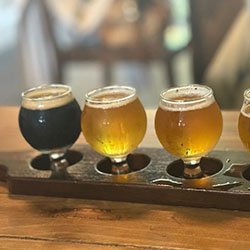You know, you can enjoy cherry blossoms in Brazil too!

The cherry blossom season is from July to August. At this time of year, it’s winter in Brazil. Even though it’s winter, it’s not as terribly cold as in Japan, so the type of cherry blossom that is common here is “Kanhizakura,” otherwise known as the Okinawa cherry (Taiwan cherry, Prunus campanulata). The flowers are deep pink. The symbolic meanings of these flowers are "whimsical," "smiling at you," and "charming beauty." There are also the Cerasus ‘Yoko’ cherry (“Sunshine cherry”) and the Wild Himalayan cherry (Prunus cerasoides). Since the climate is different from Japan, it seems there are many cherry varieties that do not grow here.
The reason Japanese people love cherry blossoms is that they symbolize the arrival of spring. And it’s also because we say the beauty of the cherry blossoms passes in a few days, and we feel the preciousness of life with sorrowful regret in our hearts. I guess beautiful cherry blossoms must have left a strong impression on the hearts of the immigrants who came to Brazil.

Carmo Park in São Paulo currently has 4,000 cherry trees. Cherry tree planting started in this park on the 70th anniversary of Japanese immigration, and today it’s a famous cherry blossom viewing spot in the city. I have heard that tree planting started because Japanese immigrants thought that if they were going to live in Brazil permanently, they would plant the Japanese cherry trees they missed so much. Some people planted them to express their gratitude to Brazilians for their willing acceptance of Japanese immigrants. Cherry trees have been planted all across Brazil, and their beauty is appreciated by the local people.
In São Paulo, you can see cherry trees around the Japanese garden in Ibirapuera Park in the center of the city. You can also see cherry trees at sports clubs and golf courses in Arujá, a city near São Paulo, which have a lot of members of Japanese descent. And cherry trees are to be found at the Kokushikan University Sports Center (400 cherry trees) in São Rocque, about 70 km from São Paulo; on the grounds of Sakura Home, a nursing home for elderly people of Japanese descent in Campos do Jordão, 180 km away; and also, in the states of Paraná, Santa Catarina, and Rio Grande do Sul, located south of São Paulo.

Cherry blossom festivals are held when the cherry blossoms bloom in their various locations. Unlike cherry blossom viewing in Japan, where you sit under the cherry blossoms around delicious lunch boxes, in Brazil they sell Japanese dishes like yakisoba (fried noodles), tempura, and sushi rolls at stalls and put on a “taiko” (drum) show. Sometimes they perform Japanese festival dances. It's more like taking photos while you stroll among the blooming cherry blossoms.
Although in Brazil it’s not like they have a new school year event with cherry blossoms in bloom, the cherry blossoms bloom only once a year, and the petals disperse in a very short period, so they even remind you on TV, “Be sure to see the beautiful cherry blossoms while they are blooming.”
In Japan, there are spots where you can enjoy the cherry blossoms lit up at night with lights, but unfortunately, they don’t have those in Brazil.
It’s thanks to Japanese immigrants that we get to enjoy seeing beautiful Japanese cherry blossoms in Brazil. I'm very grateful for that.






























































